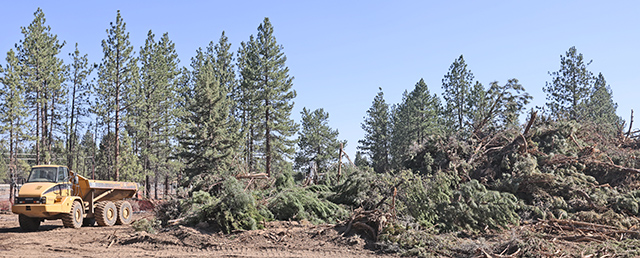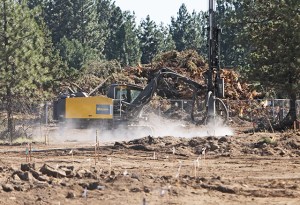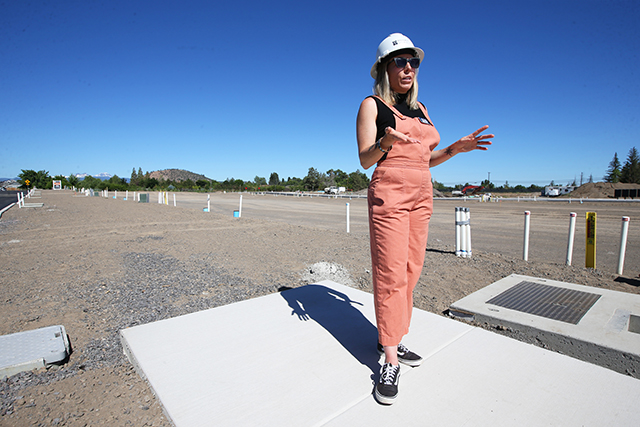Bend tree code faces early test as 1,500 trees come down for housing
Published 5:45 am Wednesday, July 23, 2025

- Trees are cut down during the process of excavating a parcel of land for a housing development in southwest Bend. 07/17/25 (Dean Guernsey/The Bulletin)
Developers will save 100 trees, replant hundreds more under rules meant to balance tree preservation and housing needs
Nearly one year after Bend passed an ordinance to preserve the city’s tree canopy from development, the policy is at work.
The result: nearly 1,500 trees will be torn down to make room for a large development in SW Bend.
A 40-acre site adjacent to U.S. Highway 97 at the edge of southwest Bend is the first major master plan development to comply with Bend’s new rules for tree preservation, which have already faced multiple challenges from home builders. The case study will help city policy makers later this year when they evaluate if the “tree code” is acting as intended: to preserve tree canopy without hindering housing production.
Trending
Developers of the Ponderosa master plan intend to build 371 homes including a mix of single-family homes, apartments and multiplexes, along with a 4.5-acre park. More than half of the units will be restricted to lower incomes.
According to tree preservation documents submitted to the city in April, developers will save about 100 of nearly 1,600 trees at the site, and make up for it by replanting 568 trees there while paying a $31,000 fee for the city to plant more elsewhere. In total, tree preservation could cost about $500,000, according to developers.
“It’s been bumpy, not for the sake of anyone being unwilling to work through it, just we’re all learning it at the same time,” said Jerry Jones, president of Macher Development, the company overseeing land development and sale for the project. Mass grading began June 24.
For Jones, the trickiest part of compliance lies in uncertainties over details in future phases of development. He said he might have the ability to save some of the trees his application slates for removal, but having to return to the city for permission to cut down more trees later on could throw a wrench in development progress. So he played it safe.
Jones said he intends to save as many trees as he can. That would also save money in mitigation fees — the $31,000 he has to pay up front. But it’s still unclear to Jones what the city’s process would be for providing a refund should he save trees later on.
Cost of replanting added to housing
Trending
Developers have several options to comply with Bend’s tree code: save 20% of trees with trunks larger than 20 inches at chest height; save enough trees where the sum of trunk width equals 25% of the total property’s total; or save 5% of total trunk width and mitigate the rest by paying the city to replant trees elsewhere or doing it themselves on their own property.
According to Jones, saving enough trees to comply with the code was not possible without reducing the number of planned homes. And to build homes efficiently, developers will have to mass grade the site.
“You can’t really carve around trees here and there,” Jones said.

Heavy equipment is used in the process of excavating a parcel of land for a housing development in southwest Bend. Mass grading began June 24. (Dean Guernsey/The Bulletin)
So when it came to either paying or planting, developers chose to do more of the latter. The plan is to plant one tree in the front yard and one in the backyard of the single-family homes.
According to Jones, that option is actually more expensive than it would have been to pay the city the $600 per tree mitigation fee. But the half-million dollar cost of complying with the tree code will be spread out over several years of building, making it more palatable.
Still, it has an impact, especially when compounded with other city fees and high costs and interest rates.
“You can’t add two trees on a lot, and add all the irrigation for that, and not put that cost on the home,” he said.
Slow learning process
The cost of trees won’t impact the affordable housing portion of the development, which is supported by $34 million in state funding. With anticipated completion in 2027, the apartments deliver 174 units restricted to people making up to $48,000 and 20 restricted to incomes of up to $24,000.
A key question in the debate over the tree code is how it will affect housing production. Earlier this year, an affordable housing provider refused to submit tree preservation plans to the city for a 30-home development, arguing the code was a violation of state law. A coalition of home builders and housing advocates led by large-scale developer Pahlisch Homes appealed the code to the state land use board shortly after it was passed, arguing it would put a damper on production.
Neither challenge was successful.
Despite threats that the code might foil progress on one of Bend’s top priorities — housing affordability — city leaders haven’t wavered in their plans to evaluate code impacts in 2025.
Councilor Megan Perkins said the city council isn’t following details of specific developments, but plans to “look at the data and determine if any updates or changes need to be made.”
Colin Stephens, the city’s community development director, said learning the impacts of the code is a slow process.
“It’s not an instantaneous feedback kind of thing,” he said.
A city council work session to evaluate the code is scheduled for October, he said.
In the meantime, the city will start working on a tree canopy plan, the blueprint for where and how the city will replant trees paid for by development mitigation fees. The city’s recently-hired urban forester, Ian Gray, will be in charge of that plan.
“It’s going to take a while to actually impact the canopy, but if we target and get trees planted in the right places, mother nature will do the rest,” Stephens said.
The code was born out of community concerns that too many trees were being lost to housing development. But some feel it still does not provide enough protection for trees.
Sheri Wheeler, a neighbor of the Ponderosa development in southwest Bend, said she was saddened to see so many trees will be removed. She hopes the city council will remove the option for developers to save only 5% of trees and instead comply with payment or replanting.
She believes developers could save more trees by reducing housing density and being more selective by leaving tree buffers.
“I just feel like they’re gobbling up every little square inch of ground they can, taking out all the trees that are allowed,” she said.









